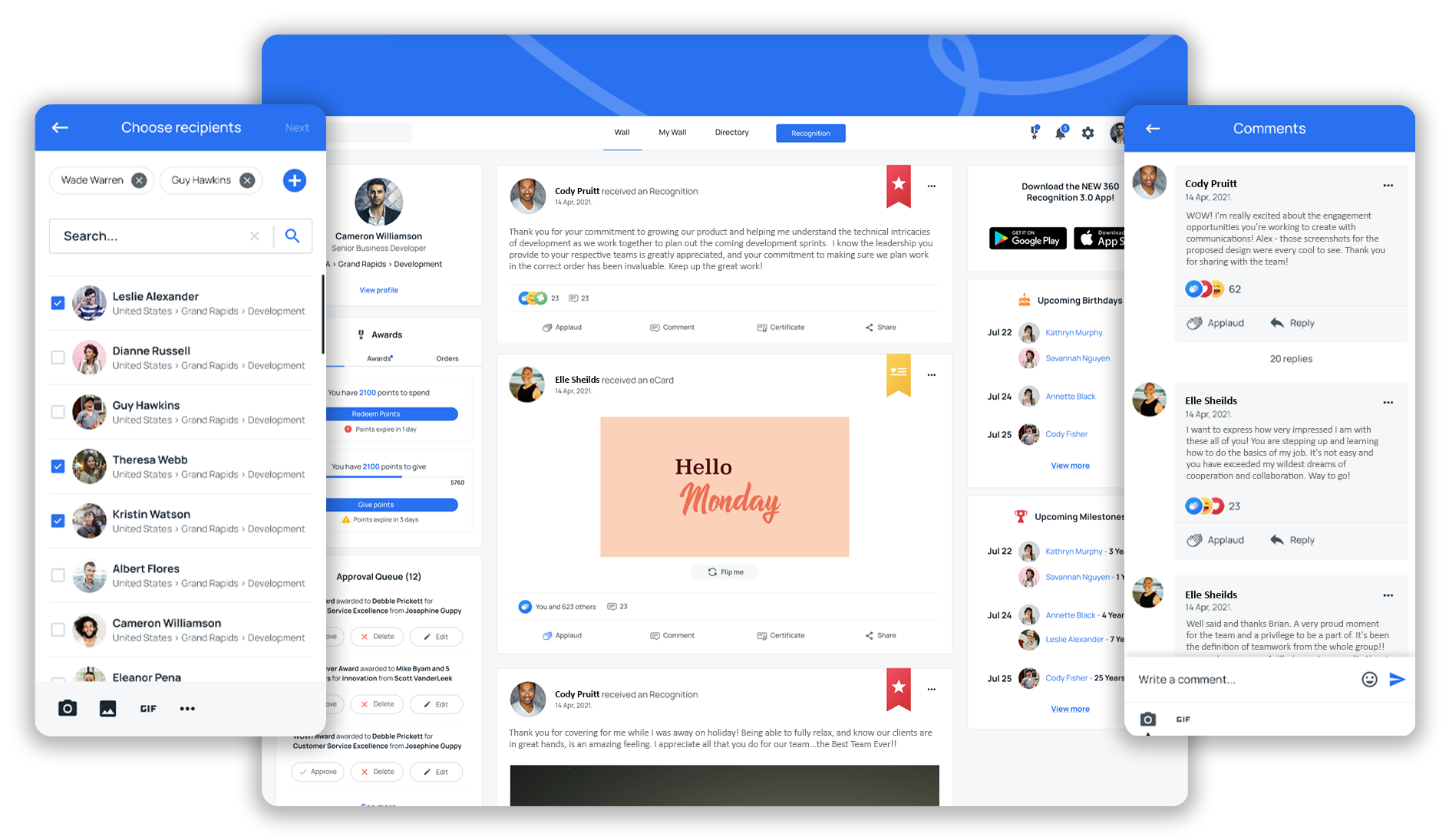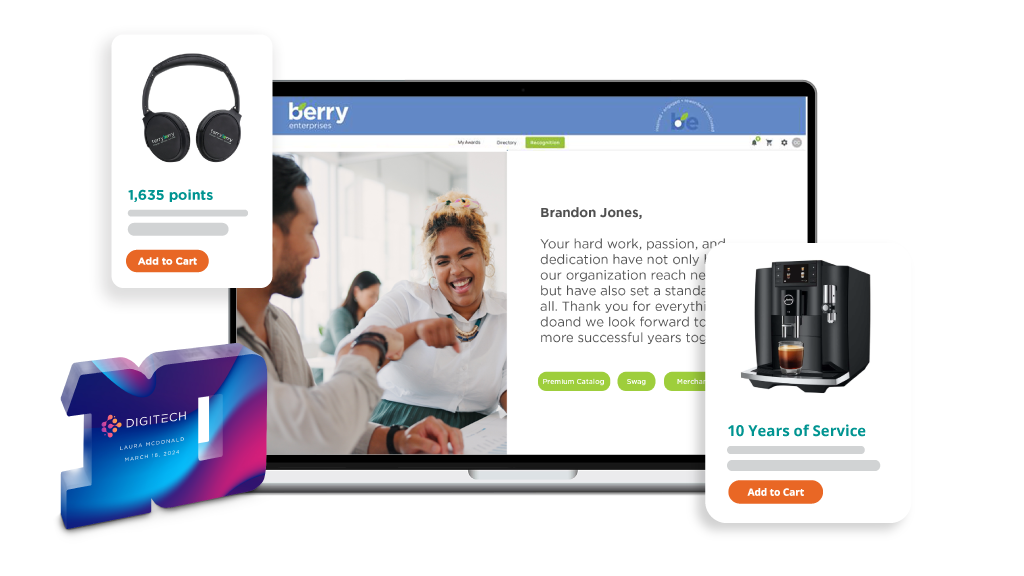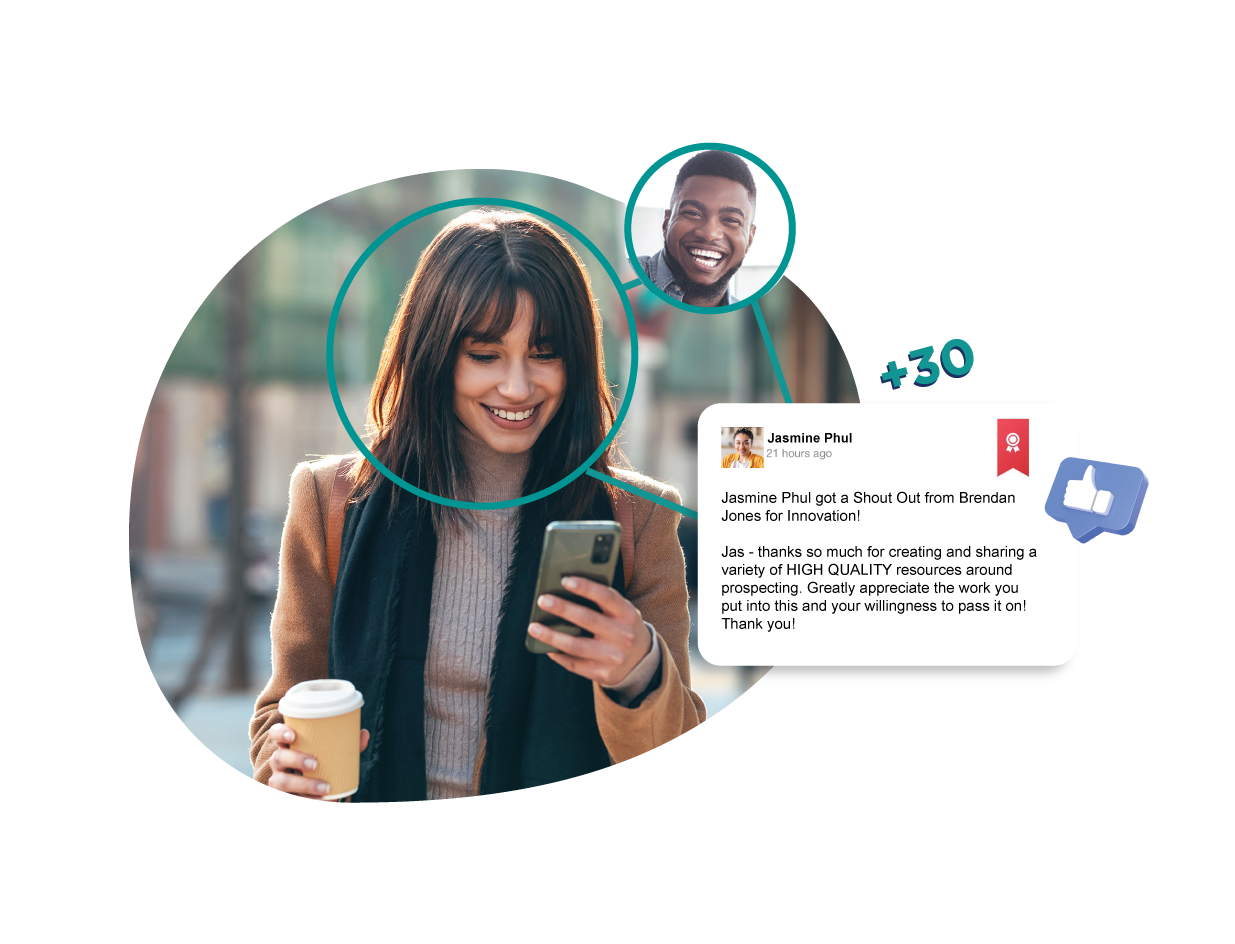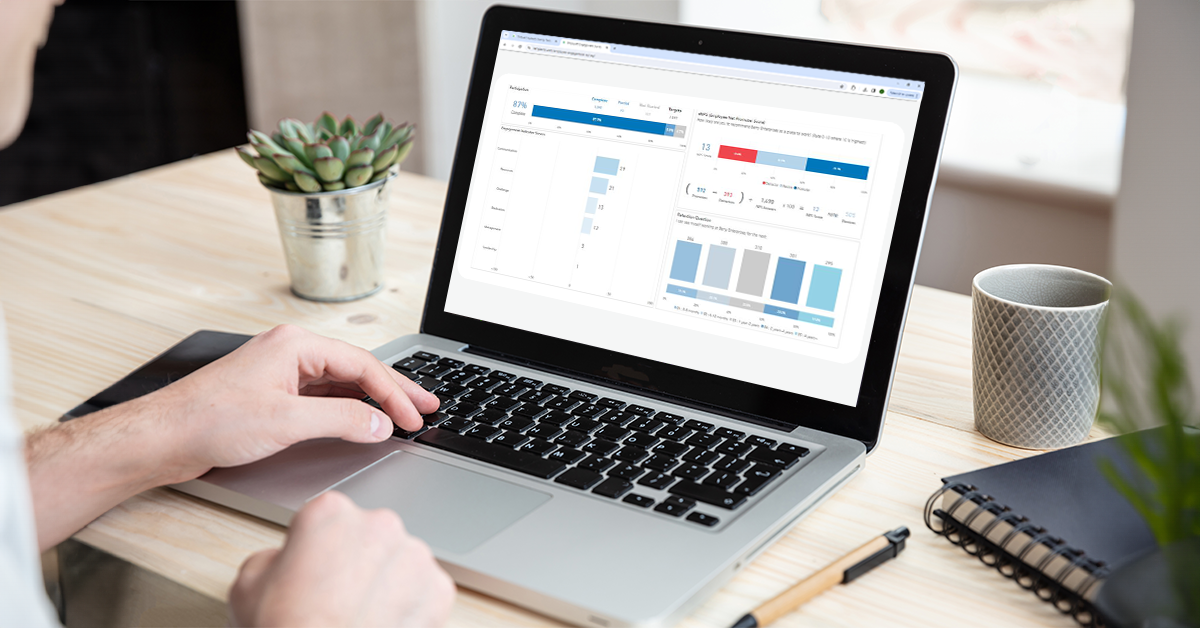November 6, 2024


Looking for peer recognition ideas to improve your workplace environment? This article offers 15 practical strategies to recognize your colleagues effectively. Discover how simple actions can make employees feel valued and appreciated.
Key Takeaways
- Implement creative recognition methods like peer shoutouts, digital badges, and recognition walls to foster a positive workplace culture.
- Celebrate employee milestones and achievements regularly to boost morale and engagement, showing that your organization values individuals beyond their work performance.
- Use technology effectively, such as peer recognition platforms and mobile apps, to make recognition immediate and accessible, creating a continuous cycle of appreciation.
What is Peer Recognition?
Peer recognition is the practice of acknowledging and appreciating the contributions and achievements of colleagues within an organization. It empowers employees to recognize and celebrate each other’s efforts and accomplishments without the need for top-down intervention or management oversight.
Peer recognition can take many forms, including verbal or written praise, public recognition, or rewards. This practice not only highlights individual achievements but also fosters a culture of mutual respect and appreciation, making the workplace more inclusive and supportive.
Importance of Peer Recognition in the Workplace
Employee recognition has been a highly studied topic over the past decade or so. And research has found some significant findings.
- According to Gallup, employees who receive regular recognition are more engaged at work. In fact, highly engaged teams show 21% greater profitability.
- A study by Bersin & Associates found that organizations with effective recognition programs have 31% lower voluntary employee turnover rates. This can lead to increased productivity and cost savings associated with recruitment and training.
- SHRM reports that 72% of employees feel that recognition given for high performance has a significant impact on improving morale. Recognized employees tend to be happier and more satisfied with their jobs.
- Globoforce research shows that companies with strategic recognition programs are 48% more likely to report high employee innovation. Recognized employees are motivated to perform better and contribute innovative ideas to the organization.
- Research from Forbes shows that 83% of employees say recognition for contributions is more fulfilling than any rewards or gifts. Recognized employees experience higher levels of job satisfaction and fulfillment.
- A study by SHRM found that companies with strong recognition programs have a 14% lower turnover rate than those without. Recognition programs can positively influence performance reviews and employee satisfaction.
- A survey by TinyPulse found that 79% of employees who quit their jobs cite a lack of appreciation as a key reason for leaving. Recognition programs contribute to a positive company culture where employees feel valued and appreciated.
Leveraging Technology for Peer Recognition
Technology can streamline the peer recognition process, making it more effective and accessible. Dedicated peer-to-peer recognition programs enhances the experience by supporting recognition, approval, and reward redemption. Mobile apps enable employees to send recognition messages conveniently, anytime and anywhere.
A point-based recognition system allows employees to reward each other with points redeemable for prizes, fostering an engaging environment through an employee recognition program. Here are some technological solutions for peer recognition:
1. Peer Recognition Platforms
Peer recognition platforms highlight employees from all areas of the business, making recognition inclusive. Social recognition enables employees to express gratitude and reward their colleagues, enhancing accessibility.
Effective peer recognition platforms offer easy management, customization, and tracking of results. These platforms are also effective for recognizing remote and deskless employees, emphasizing the importance of inclusive recognition strategies in a hybrid workforce.
Choosing an easy-to-use application is crucial for a successful recognition program. A virtual tool like a Kudos Slack channel can enhance recognition efforts interactively.
2. Mobile Apps for On-the-Go Recognition
Mobile recognition apps allow employees to send acknowledgment messages instantly, enhancing the recognition process by making it immediate and accessible. The convenience of mobile apps ensures employees can share recognition experiences anytime, anywhere.
Adopting mobile recognition apps fosters a continuous recognition cycle, significantly enhancing workplace culture.
3. Gamified Recognition Systems
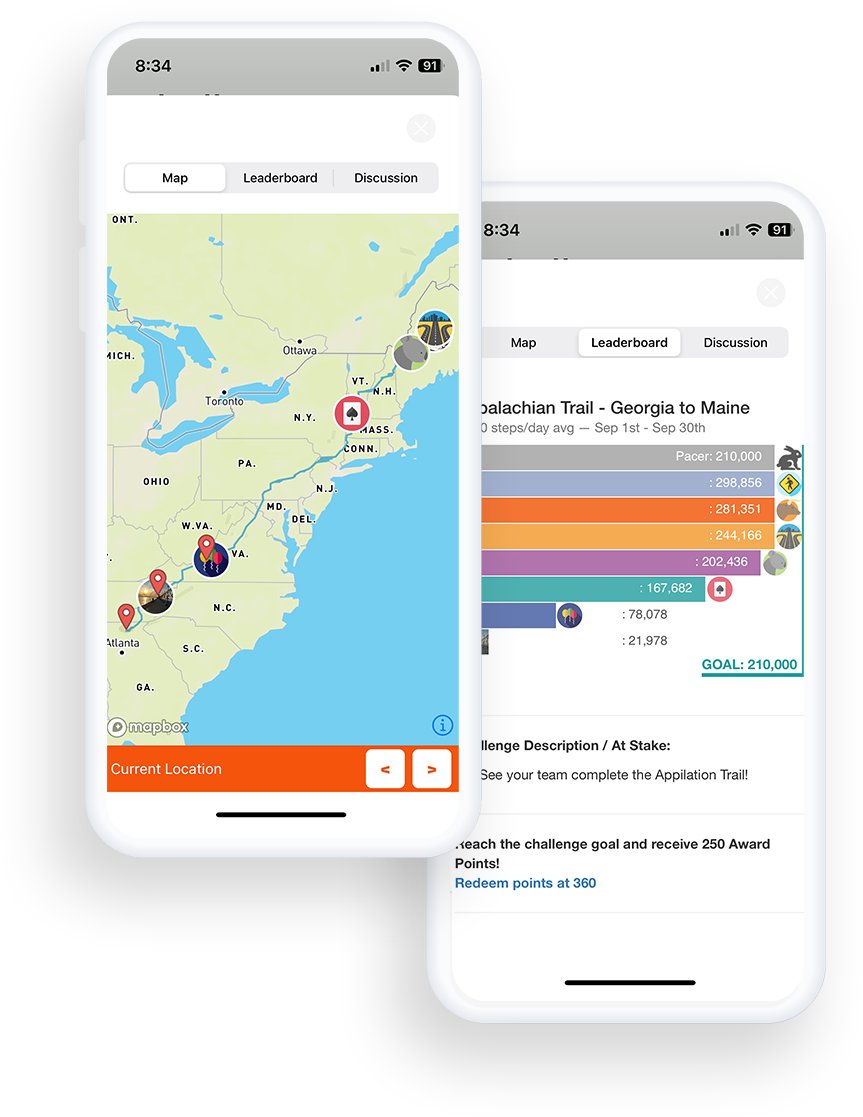

A point-based system in recognition programs motivates employees to collaborate and work towards shared goals. Gamified systems can include achievement levels and challenges to enhance the recognition experience.
Integrating gamification into recognition programs fosters a more engaging and fun workplace culture.
Creative Ways to Recognize Peers
Innovative peer recognition ideas can foster a positive work environment by promoting teamwork, collaboration, and a sense of belonging among employees. Creative methods like peer shoutouts on social media, digital badges, and recognition walls make acknowledgment more memorable and impactful.
Peer recognition sparks joy, reinforces positive behavior, and boosts motivation, making employees feel appreciated and valued, which can ultimately help to boost employee morale and encourage employees to enhance employee recognition.
Here are some creative ways to recognize peers:
4. Peer Shoutouts on Social Media
Acknowledging peers on social media enhances engagement and performance. Employees can share thoughtful posts on platforms like LinkedIn and tag colleagues. This form of social media recognition not only highlights the achievements of peers but also promotes a culture of appreciation across the organization.
5. Digital Badges and Certificates
Digital badges and certificates motivate individuals and reinforce appreciation. Visual methods like certificates, trophies, and pins make recognition tangible and memorable.
Recognizing personal milestones like graduations or marathon completions adds a personal touch. Digital badges and certificates are flexible and suitable for recognizing both in-person and remote employees.
6. Recognition Walls
A recognition wall, whether physical or virtual, serves as a visual reminder of employee achievements, boosting morale and fostering a sense of community.
Celebrating Milestones and Achievements
Celebrating milestones in the workplace personalizes the experience and helps employees feel valued, fostering a culture of festivity and appreciation. Acknowledging accomplishments enhances employee morale, engagement, and retention rates.
Here are specific ways to celebrate milestones:
7. Work Anniversaries
Celebrating work anniversaries acknowledges long-term commitment and fosters a sense of belonging. With social recognition software, employees can receive a virtual collection of messages from colleagues and bosses on their work anniversary, making the celebration more personal.
Recognition software like Terryberry's can also streamline the process by notifying admins of employee anniversaries, and connecting recipients to an employee rewards platform.
8. Project Completion Parties
An often overlooked opportunity for recognition is project completions. Celebrating project completions reinforces teamwork and collective achievement, boosting team spirit and creating a collaborative work environment.
Send a message on your recognition software acknowledging the team who worked on the project, or give a shoutout in a company-wide meeting. Or, even better, do both!
9. Personal Milestones
Recognizing personal milestones such as birthdays, engagements, or personal achievements shows that you value your employees beyond their productivity, which enhances workplace culture and promotes employee engagement.
Organizing events to celebrate personal milestones like small gatherings, personalized notes, or small gifts, help ensure employees feel appreciated and valued.
Inclusive Recognition Practices
Whether real or perceived, a common pitfall with employee recognition is favoritism. Some employees will naturally succeed more often than others. Finding a balance between recognizing these employees, while not fostering resentment in others, can be a challenge.
Keeping this in mind, inclusive recognition is critical. Here are some inclusive recognition practices to benefit your workplace:
10. Cross-Departmental Recognition
Recognizing another team member that has supported your department fosters collaboration among team members and prevents silos. Consider celebrating with virtual coffee breaks or happy hours to foster connections.
Departments can nominate each other for recognition weekly, setting an example of cross-departmental appreciation.
11. Tailored Recognition Methods
Aligning recognition approaches with individual preferences ensures employees feel valued, resulting in higher motivation. Introverted employees might prefer private recognition, while extroverts might enjoy public acknowledgment.
Understanding each employee’s preferences helps create a more inclusive recognition program, ensuring all employees feel appreciated and motivated. Additionally, aligning recognition methods with company values fosters a sense of belonging and loyalty among employees.
12. Cultural Sensitivity in Recognition
Cultural sensitivity in recognition respects diverse backgrounds and celebrates the unique contributions of employees from different cultures.
Employers can recognize employees through charitable giving by offering opportunities for donations to causes significant to diverse cultures.
Encouraging Leadership Participation
Leaders influence culture and can model recognition behavior. Encouraging leaders to embrace peer-to-peer recognition can significantly enhance the overall workplace environment.
Here’s how leadership participation can boost the effectiveness of peer recognition programs:
13. Training Leaders in Effective Recognition
Incorporating recognition training into leadership development integrates appreciation as a core value. Training leaders in effective recognition practices ensures they understand the importance of acknowledging contributions and can model this behavior.
14. Leading by Example
Leaders should model desired behavior and recognize team success, including personalization and acknowledgment of specific contributions in their messages.
Active participation in peer recognition by senior leadership sets a positive example for the team.
15. Regular Recognition from Management
Management should frequently recognize team contributions to establish a standard of appreciation. Surprising employees with recognition fosters trust and loyalty. Only a small percentage of companies provide frequent recognition, but those that do, like General Motors, see significant benefits in employee engagement and loyalty.
Each employee at General Motors receives at least one recognition per month on average, contributing to a high activation rate for the recognition platform.
Establishing an Effective Recognition Program
Define Your Program’s Objectives and Goals
Before implementing a peer recognition program, it’s essential to define the program’s objectives and goals. What do you want to achieve with your recognition program? Is it to boost employee morale, increase employee engagement, or improve company culture?
By setting clear objectives and goals, you can create a program that is tailored to your organization’s specific needs and values. Some possible objectives and goals for a peer recognition program include:
- Boosting employee morale and motivation
- Increasing employee engagement and participation
- Improving company culture and values
- Recognizing and rewarding outstanding performance and achievements
- Encouraging teamwork and collaboration
- Providing positive feedback and reinforcement
By defining your program’s objectives and goals, you can create a clear roadmap for implementation and evaluation. This will help you to ensure that your program is effective, efficient, and aligned with your organization’s overall mission and values.
Some possible ways to define your program’s objectives and goals include:
- Conducting employee surveys and focus groups to gather feedback and insights
- Reviewing company data and metrics to identify areas for improvement
- Consulting with HR and management to align the program with company goals and values
- Researching best practices and industry benchmarks for peer recognition programs
By taking the time to define your program’s objectives and goals, you can create a peer recognition program that is tailored to your organization’s unique needs and values. This will help you to achieve your desired outcomes and create a positive and productive work environment.
3 Ways to Measure the Impact of Peer Recognition
Measuring the impact of peer recognition programs is crucial for understanding their effectiveness and making necessary adjustments. Successful peer-to-peer recognition programs should focus on clarity, consistency, and inclusivity in the peer recognition model.
Consistent monitoring and tracking progress is important for maintaining an effective peer recognition program.
1. Employee Feedback Surveys
Employee engagement surveys are a direct method to collect insights about the effectiveness of recognition programs. Surveys can effectively assess the impact of recognition programs on employee morale. By gathering feedback from employees, organizations can identify areas for improvement and ensure that recognition practices are meeting their needs.
Regularly conducting employee feedback surveys helps maintain a pulse on how recognition programs are perceived and their impact on overall employee engagement and satisfaction. This data is invaluable for making informed decisions about program adjustments.
2. Peer Recognition Programs Metrics
Participation metrics in recognition programs are crucial for analyzing engagement levels. Tracking recognition frequency can help organizations understand its impact on employee satisfaction. Consistent recognition frequencies can lead to better overall employee engagement.
Feedback from recognition metrics should guide program adjustments to maintain their effectiveness.
3. Adjusting Programs Based on Data
Collecting feedback from employees through surveys can provide valuable insights into the effectiveness of peer recognition programs and highlight areas for improvement. Tracking key metrics such as participation rates, frequency of recognition, and overall employee satisfaction is essential for evaluating the effectiveness of employee recognition programs.
Data gathered from employee feedback and metrics should be used to make informed adjustments to recognition strategies, ensuring they meet the evolving needs of employees. Continuously refining recognition programs based on data insights helps maintain their relevance and effectiveness in enhancing work culture.
Summary
Recognizing peers in the workplace is more than just a nice gesture—it’s a powerful tool that can transform company culture. From creative recognition ideas to leveraging technology and encouraging leadership participation, there are numerous ways to ensure that all employees feel appreciated and valued.
By celebrating milestones, promoting inclusivity, balancing public and private recognition, and incorporating fun activities, organizations can create a more engaging and supportive environment.
Remember, a well-implemented peer recognition program not only boosts morale and productivity but also fosters a culture of appreciation and collaboration.
Interested in learning more about how your company can benefit from a recognition program? Schedule a demo of Terryberry's Be Recognized Platform today.


